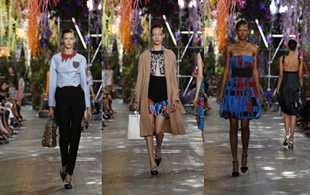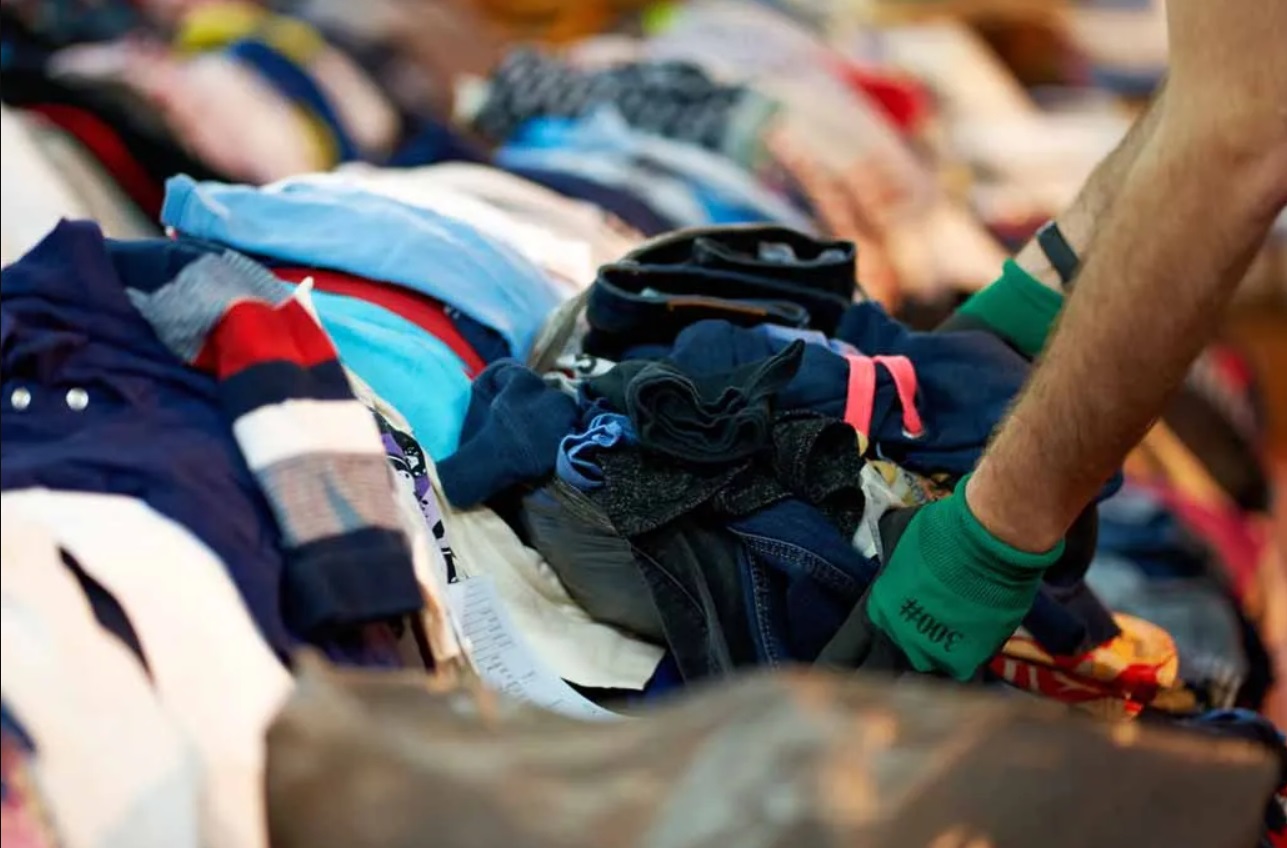FW
The International Apparel Federation (IAF) and the International Foundation of Fashion Technology Institutes (IFFTI) have decided to jointly put in efforts to establish a better connect between business and education in the fashion sector. IAF secretary general Han Bekke and IFFTI secretary Commodore Vijay Chaturvedi recently signed a memorandum of cooperation in Tokyo during IFFTI’s 16th annual conference.
IAF’s education committee of representatives from the industry is chaired by Souraya Bouwmans, Dean of Amsterdam Fashion Institute, who is also member of the Executive Committee of IFFTI. Both institutes have reached a consensus on working closely for IAF’s awards program. IFFTI members will promote the opportunity of participating in the IAF student award to their graduating students.
Students will enter the competition with their graduation work in the categories design, product development and branding. The prize will be a half year fully paid internship at a fashion company.
They, together will also organise the IAF designer award. IFFTI members will invite alumni to apply for the award and to nominate one designer not already internationally known but nationally strong, with a maximum of 5 years of professional experience. The winner of the IAF Designer Award is given a fully paid visit to the IAF World Fashion Convention the next year. There the winner can present his or her winning collection on the catwalk to representatives of industry and press.
IAF is the world’s leading federation for apparel manufacturers, their associations, apparel retailers and the supporting industry. Whereas, IFFTI is an international body comprising of leading international fashion universities and schools focused on helping its members in upgrading their programs, assist in bringing about sharp professionalism in the structure and operation of the fashion industry in their respective countries.
Iafnet.eu
Bangladesh garment exports to non-traditional markets have grown more than four times in the last six years. In 2008, garment exports to destinations other than the EU stood at $800 million and in 2013 the figure crossed $3.5 billion.
Along with its traditional export destinations --the US, EU and Canada -- Bangladesh is focusing on new destinations like India, China, Russia, Japan, South Africa, Turkey, South Korea, Malaysia, Australia and New Zealand. The country is also exploring the possibility of exporting to Nigeria, Saudi Arabia and Chile by strengthening the South-South Cooperation. The South-South Cooperation is a broad framework for collaboration among countries of the south.
The Bangladesh government is enhancing skills to boost export of skilled manpower. Skill development can promote overseas employment of Bangladeshi workers.
The Bangladesh government in 2009 had introduced a financial package to encourage garment manufacturers to explore new destinations. Under the scheme, the government gave 5 per cent cash incentive to exporters in fiscal 2009-10, 4 per cent in fiscal 2010-11 and 2 per cent in fiscal 2011-12. Exporters receive a 2 per cent cash incentive for exporting to new destinations.
China will no longer support a strategic reserve for cotton. This means cotton production and cotton-related industries will no longer be shielded from the forces of the free market. Chinese domestic textile mills can source their raw cotton from the free market.
The impact will be to allow both cotton plantings and production to decline, allowing other countries to seed more land area to cotton. The US will be firmly entrenched in the foreseeable future with 11.5 million acres under cotton. Yet cotton will still be a commodity, and thus will find favor mostly in areas of low cost production regions like Vietnam, Cambodia, Laos, Bangladesh and Myanmar.
In China other industries have surpassed the textile industry. The textile mills have become outdated and are too inefficient to operate. Just as it occurred in Europe of the 1800s, Japan and South Korea in the late 1900s and the US in the early 2000s, now the textile industry is exiting Chinese shores. Right now China has the world’s largest textile industry but India may soon claim that position.
The 32nd International Cotton Conference will be held in Bremen, Germany, from March 19 to 21, 2014. The theme of the 2014 conference will be, understanding consumer attitudes and expectations about cotton. Among the issues to be debated are: What does the consumer expect? How can the cotton and textile industries meet these expectations? What effect do trends in consumer preferences have on the clothing market, and what trends are developing now? What exactly makes cotton a unique fiber in the eyes of people all around the world?
The conference is a meeting opportunity for people from all sides of the cotton business, from the cotton seed producer to the retailer. The International Cotton Conference began at Bremen in the 1950s and dealt exclusively with matters of cotton testing, before developing over the years to include more and more on cotton production and the next stages of the textile chain.
For 2014 analyses, findings, research results and solutions will be presented and discussed on everything from cotton growing through processing and equipment to everyday comfort. Sustainability in production, textile processing and the use of clothing, which is becoming increasingly important for the end consumer, will also be looked at.
www.baumwollboerse.de/index.php?l=2..&n=27,58,0
Swiss textiele machinery maker Rieter expects financial year 2013 to give better results with its spun yarn systems and premium textile components. The company is expecting a net profit of around 3.5 per cent of sales. Rieter is a leading world supplier of textile machinery and components used in short staple fiber spinning. Based in Switzerland, the company develops and manufactures systems, machinery and technology components used to convert natural and manmade fibers and their blends into yarns. It is the only supplier worldwide to cover spinning preparation processes as well as all four final spinning processes currently established in the market.
Rieter received 50 per cent improvement in orders for its spun yarn systems and a 21 per cent improvement in orders for premium textile components. Short staple fiber machinery and components gained momentum during 2013. There was notable growth in Rieter’s business in the second semester, especially for rotor spinning machines. The first half year showed strong demand in China and because of Rieter’s local presence in the market. There was healthy demand from Pakistan, Uzbekistan, South Korea, Bangladesh, Indonesia and Vietnam. Order level from India rose in the second half of the year at a modest level.
www.rieter.com/
Cases have been filed against 1,683 factories and establishments in Bangladesh, including 392 garment units, for doing business without valid approval and adequate safety measures. Inspectors are focusing mainly on fire safety standards, including fire prevention measures, electrical safety, number of staircases, provision of 25 per cent open rooftop and a valid license. They found workers were not registered, no appointment letters and identification cards with no photos, no regular fire drills, obstacles in passages and absence of benefits like maternity leave. Besides, a large number of factories were not fully compliant with fire safety standards.
However, it’s doubtful if such a step will yield positive results. For one, fines are too low to deter offenders. Many a time, owners pay the penalty and carry on as usual. The inspection teams themselves are facing a shortage of manpower. The ministry has made a move to appoint additional 200 inspectors by March next.
The government is focusing on garment factories due to frequent accidents, pressure from the buyers, and the image crisis the sector is now facing. The country’s garment industry has in recent times been hit by a series of devastating fires and building collapses leading to loss of lives and damage to property.
 REPORT_ Under Armour has announced its financial results for the fourth quarter ended December 31, 2013 with net revenue increase of 35 percent to 683 million dollars compared with net revenues of 506 million dollars in the prior year's period. For the full year 2013, net revenues increased 27 percent to 2.33 billion dollars compared with 1.83 billion dollars in the prior year and compared with the company's prior outlook of 2.26 billion dollars.
REPORT_ Under Armour has announced its financial results for the fourth quarter ended December 31, 2013 with net revenue increase of 35 percent to 683 million dollars compared with net revenues of 506 million dollars in the prior year's period. For the full year 2013, net revenues increased 27 percent to 2.33 billion dollars compared with 1.83 billion dollars in the prior year and compared with the company's prior outlook of 2.26 billion dollars.
Diluted earnings per share for 2013 increased 24 percent to 1.50 dollars compared with 1.21 dollars per share in the prior year. Diluted earnings per share for the fourth quarter of 2013 increased 27 percent to 0.59 dollars compared with 0.47 dollars in the prior year’s period.
with 1.21 dollars per share in the prior year. Diluted earnings per share for the fourth quarter of 2013 increased 27 percent to 0.59 dollars compared with 0.47 dollars in the prior year’s period.
Fourth quarter apparel net revenues increased 35 percent to 546 million dollars compared with 405 million dollars in the same period of the prior year, primarily driven by expanded Fleece offerings and new ColdGear Infrared products. Fourth quarter footwear net revenues increased 24 percent to 55 million dollars from 45 million dollars in the prior year's period. Fourth quarter accessories net revenues increased 52 percent to 65 million dollars from 43 million dollars in the prior year's period, primarily driven by headwear and gloves.
Commenting on the results, Kevin Plank, Chairman and CEO of Baltimore-based Under Armour stated, “By any measure, 2013 was a banner year for the UA Brand. We surpassed 2 billion dollars in net revenues for the year, which culminated with our 15th straight quarter of at least 20 percent total growth. In addition, we completed our first acquisition, MapMyFitness, opened our first two UA Brand House retail stores, and continued to make key investments in our Women's, Footwear and International businesses to drive long-term global growth. While we are proud of what we have accomplished to date, we firmly believe we are just getting started and that our performance in 2013 is indicative of the opportunity that lies ahead for Under Armour.”
Apparel net revenues for the year 2013 increased 27 percent to 1.76 billion dollars compared with 1.39 billion dollars in the prior year, led by elevated newness across product categories like HeatGear and Fleece as well as innovation platforms including Storm, ColdGear Infrared and Charged Cotton. Footwear net revenues increased 25 percent and accessories net revenues increased 30 percent, primarily driven by headwear and gloves.
Based on current visibility, the company expects 2014 net revenues in the range of 2.84 billion dollars to 2.87 billion dollars, representing growth of 22 percent to 23 percent over 2013, and 2014 operating income in the range of 326 million dollars to 329 million dollars, representing growth of 23 percent to 24 percent over 2013.
Added Plank saying, “We have tremendous momentum across our business and we will leverage this strength to fuel our global growth ambitions in 2014. To start, we have recently formed partnerships with three sports programs with deep, proud heritages: the University of Notre Dame, the U.S. Naval Academy, and the Colo Colo fútbol team in Chile.”
NALYSIS_ In an unexpected movement, Men's Wearhouse Inc (MW.N) has just said it is open to sweetening its buyout offer for Jos. A. Bank Clothiers Inc (JOSB.O). The now suitor has outlined new conditions to appeal to its rival management and called on independent directors of Jos. A. Bank Clothiers Inc to reconsider its bid.
"We are writing to you, the independent directors of Jos. A. Bank Clothiers, Inc. ("JOSB"
 or the "Company"), regarding our all-cash 57.50 dollars per share offer to acquire the Company. As we have made clear, our strong preference is to work collaboratively with the JOSB Board and management to realise the benefits of this combination. Our offer would provide your shareholders with a substantial premium and immediate and certain value," reads the letter, dated on January, 30. the wake of the news, Jos. A. Bank shares were up marginally in early tradingThursday after rising as much as 3 percent before the bell.
or the "Company"), regarding our all-cash 57.50 dollars per share offer to acquire the Company. As we have made clear, our strong preference is to work collaboratively with the JOSB Board and management to realise the benefits of this combination. Our offer would provide your shareholders with a substantial premium and immediate and certain value," reads the letter, dated on January, 30. the wake of the news, Jos. A. Bank shares were up marginally in early tradingThursday after rising as much as 3 percent before the bell.
Barely days before the new turn for the complex hate-love relationship between the two US-based menswear giants, had Men's Wearhouse declared a quarterly dividend for investors of record on Tuesday, March 18th, who will be given a dividend of 0.18 dollars per share on Friday, March 28th. This represents a 0.72 dollars dividend on an annualised basis and a yield of 1.52 percent.
Men´s Wearhouse to lure independent directors at Jos A. Bank
"Our offer represents a 52 percent premium over JOSB's unaffected enterprise value and a 38 percent premium over the closing share price on October 8, 2013, the day prior to the Company's public announcement of its proposal to acquire Men's Wearhouse."
"Further, the transaction represents a 9.4x enterprise value to last twelve months ("LTM") Adjusted EBITDA multiple (assuming 135 million dollars of LTM Adjusted EBITDA as of November 2, 2013), which is a significant premium to Jos. A. Bank's proposal to acquire Men's Wearhouse, in excess of Jos. A. Bank's historical average trading multiple and near the upper end of recent precedent apparel retail transactions. Moreover, we are prepared to increase our offer price if you can demonstrate or we can discover additional value through discussions or limited due diligence."
Jos. A. Bank Clothiers Inc. (JOSB), which is resisting a takeover by Men's Wearhouse Inc., would have allegedly told by five of its largest shareholders to start talking to its rival about a sale, as per sources quoted by Bloomberg.
Firms including P. Schoenfeld Asset Management LP and Beacon Light Capital LLC would have urged Jos. A. Bank to engage Men's Wearhouse and discuss its 1.61 billion dollars hostile bid anonymous sources close to the matter have pointed out. The five investors own about 17 percent of Jos. A. Bank, according to the people and data compiled by Bloomberg.
 REPORT_ Salvatore Ferragamo consolidated revenues for the fiscal year 2013 were up by 9 percent at current exchange rates and by 11 percent at constant exchange rates versus financial year 2012. All geographical areas, with the sole exception of Japan, registered in financial year 2013 a double-digit growth in turnover. The Asia Pacific area is confirmed as the group’s top market in terms of revenues, representing about 37 percent of the total in financial year 2013. A major contribution was given by the retail channel in China, which recorded a 20 percent growth compared to the same period in 2012.
REPORT_ Salvatore Ferragamo consolidated revenues for the fiscal year 2013 were up by 9 percent at current exchange rates and by 11 percent at constant exchange rates versus financial year 2012. All geographical areas, with the sole exception of Japan, registered in financial year 2013 a double-digit growth in turnover. The Asia Pacific area is confirmed as the group’s top market in terms of revenues, representing about 37 percent of the total in financial year 2013. A major contribution was given by the retail channel in China, which recorded a 20 percent growth compared to the same period in 2012.
Europe posted an increase in revenues of 13 percent, compared to the same period in  2012. Double-digit revenue growth was recorded also in North America, with an increase of over 12 percent in financial year 2013. The Japanese market showed an increase in revenues of one percent in financial year 2013. Revenues in Central and South America showed an increase of 15 percent. Salvatore Ferragamo is based in Italy. The group is active in the creation, production and sale of shoes, leather goods, clothing, silk products and other accessories, as well as women’s and men’s perfumes. The group’s product range also includes eyewear and watches, manufactured by licensees.
2012. Double-digit revenue growth was recorded also in North America, with an increase of over 12 percent in financial year 2013. The Japanese market showed an increase in revenues of one percent in financial year 2013. Revenues in Central and South America showed an increase of 15 percent. Salvatore Ferragamo is based in Italy. The group is active in the creation, production and sale of shoes, leather goods, clothing, silk products and other accessories, as well as women’s and men’s perfumes. The group’s product range also includes eyewear and watches, manufactured by licensees.
As of December 31, 2013, the Salvatore Ferragamo group’s retail network consisted of 360 Directly Operated Stores while the wholesale and travel retail channel included 264 Third Party Operated Stores as well as a presence in major department stores and high-end multi-brand specialty stores. In financial year 2013 the retail distribution channel posted consolidated revenues up by 9 percent compared to the same period in 2012. The wholesale and travel retail channel delivered an excellent performance in financial year 2013 growing 14 percent.
 ANALYSIS_LVMH took Paris bourse by storm Friday after the world largest luxury goods group hit the 6 billion euros annual profit landmark for the first time. The 2 percent rise in profit for the full year boosted the stock by nearly 7 percent to 131 euros. LVMH was a winnerFriday, not only in terms of full-year profit, but also on the trading floor. The shares advanced as much as 6.9 percent, the sharpest intra-day gain since May 10, 2010.
ANALYSIS_LVMH took Paris bourse by storm Friday after the world largest luxury goods group hit the 6 billion euros annual profit landmark for the first time. The 2 percent rise in profit for the full year boosted the stock by nearly 7 percent to 131 euros. LVMH was a winnerFriday, not only in terms of full-year profit, but also on the trading floor. The shares advanced as much as 6.9 percent, the sharpest intra-day gain since May 10, 2010.
The French luxury giant got an important push from its fashion and leather-goods  divisions, which sales rose 7 percent on an organic basis in the final three months of the year. Growth accelerated from 4 percent in the first nine months of 2013, after a weaker third quarter. Sales for the year came in at 29.1 billion euros, that is it a 4 percent on the previous year. Profit reached 6.021 billion pounds, a record amount that came in 2 percent up year-on-year.
divisions, which sales rose 7 percent on an organic basis in the final three months of the year. Growth accelerated from 4 percent in the first nine months of 2013, after a weaker third quarter. Sales for the year came in at 29.1 billion euros, that is it a 4 percent on the previous year. Profit reached 6.021 billion pounds, a record amount that came in 2 percent up year-on-year.
Despite the green sprouts, market remains cautious, as although the results showed improvement in the fourth quarter of 2013, the annual sales growth remained below the previous year´s.
Commenting the results, the group reminded that, in order to improve performance and turnover, LVMH has launched a more expensive range of "very high quality leather products" where it today said "profitability remains at an exceptional level."
LVMH shares hit 3-year record high in Paris
The improved performance of the unit was the "main positive" in yesterday's full-year results, Rogerio Fujimori, an analyst at Credit Suisse, said in a note.
LVMH shares gained nearly 7 percent on the positive outlook and reverted thus the last twelve months´ 7.6 percent fall due to slowing luxury-goods sales in Asia.
Profit from recurring operations climbed 2 percent to 6.02 billion euros, in line with the median of 19 analysts' estimates compiled by Bloomberg. Similarly, total 2013 revenue advanced to 29.15 billion euros. Analysts predicted 29.4 billion euros. Sales rose 8 percent on an organic basis, matching estimates.
"Despite an uncertain economic environment in Europe, LVMH is well-equipped to continue its growth momentum across all business groups in 2014," the company said.












